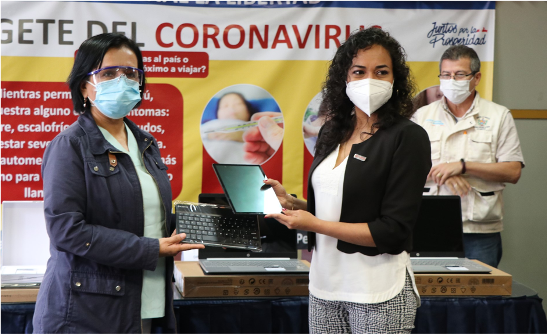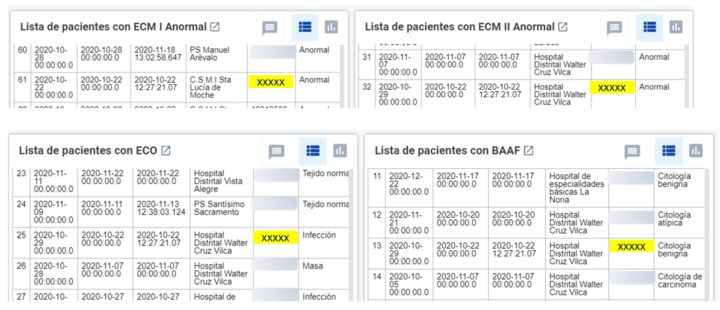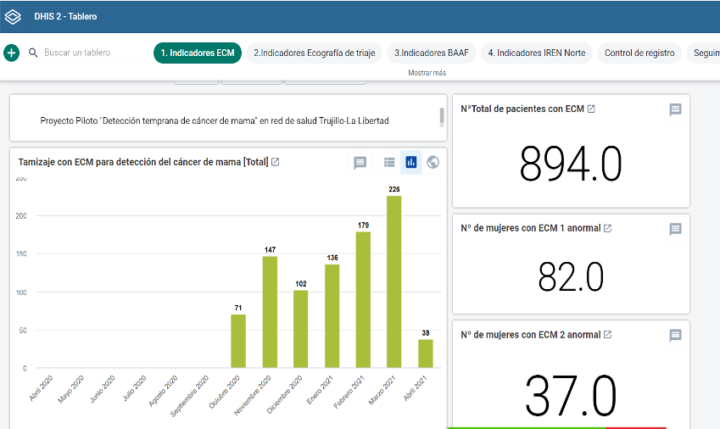
Tracking Breast Cancer Patients in Peru with DHIS2
PATH, EHAS and the regional Ministry of Health of Trujillo, Peru worked together to design and implement an electronic breast cancer registry to facilitate real-time patient tracking and follow-up
Breast cancer is the most common cancer among women in Peru, with high mortality. Since 2016, PATH has scaled up a breast cancer detection model in Trujillo, Peru in partnership with the regional Ministry of Health (MoH). The model includes clinical breast exam (CBE), ultrasound triage (UT) and fine needle aspiration biopsy (FNA). Through mid-2020, this was done using paper-based clinical forms.
Trujillo has a population of over 900,000 people. With around 6,000 women per year aged 40-69 being monitored by the regional MoH for breast cancer, capacity for adequate patient follow-up using paper forms was limited. Some of the specific challenges identified were:
- Lack of a digital system for tracking breast cancer detection visits from clinical breast exam (CBE) at primary level, to ultrasound triage, FNA biopsy (secondary level) and diagnosis, and finally treatment (tertiary level).
- Weak, paper-based, referral system for patient follow-up and diagnosis when a woman was referred with an abnormal CBE.
- Primary and secondary level health providers did not know cancer diagnosis results or treatment plans for their patients referred as highly suspicious for cancer.
- Lack of a digital system to calculate time elapsed between first screening visit and final diagnosis.
To address this, in early 2020 the MoH, PATH and Enlace Hispano Americano de Salud (EHAS) launched a pilot implementation of an electronic breast cancer registry in Trujillo using DHIS2 Tracker.

Designing a Tracker program for real-time monitoring of suspected breast cancer cases through all stages of diagnosis and care
The aim of the pilot project in Trujillo was to implement a digitalized approach that would allow health workers to trace individual patients — including their diagnostic results, referrals and care received — across the three levels of health care for breast cancer detection activities, with reports generated at each level up to the Regional Cancer Institute (IREN Norte). The team selected the DHIS2 Tracker application for case-based data to collect, manage and analyze this information. While DHIS2 is currently used as an eRegistry for a variety of health programs around the world, there are few examples of Tracker being used specifically as a cancer registry. Thanks to the flexible nature of the DHIS2 platform, PATH, EHAS and the MoH were able to create a customized Tracker program adapted to their use case and workflow.
First, data on women receiving CBE at the primary health care level are collected and entered in Tracker, using either the web-based DHIS2 portal on laptop computers, or the DHIS2 Android Capture App on tablets at clinics that lack stable internet connections. Women with positive CBE results are referred for UT. If necessary, FNA biopsy is performed. In cases where cancer is suspected, the woman is referred to the regional cancer institute for diagnostic confirmation and treatment initiation. Throughout this process, DHIS2 ensures that the patient’s diagnostic, treatment and referral information are available electronically at each level, and provides feedback to health workers on women who need follow-up. The system also creates reports of total number of CBE performed, abnormal CBE, UT, FNA, cancer diagnosis, and treatment initiation, collectively and individually, per health facility. These reports help health managers monitor the overall performance of the breast cancer program, while DHIS2’s built-in analytics tools allow them to analyze cancer screening and diagnosis statistics.

Collaborating on design, implementation and capacity building to support local system ownership for long-term sustainability
The overall design of the pilot project and of the DHIS2 Tracker system was carried out in a close collaboration between PATH, EHAS and Trujillo’s MoH. First, the 14 health facilities that took part in the pilot were selected based on criteria including having trained staff for performing CBE and computer skills. The team then met to determine the indicators and variables that would be included in the system. Routers, tablets and laptops and other network hardware were provided to the health facilities to improve internet access. An IT professional was hired to provide support and hosting for the DHIS2 instance was arranged.

Once the system was configured, the team began user training. The onset of the COVID-19 pandemic in March 2020 required the team to pivot from in-person to virtual capacity building. The first five-day training was held in July 2020, led by the EHAS team from Spain. This training was for coordinators from the MoH and PATH at the regional level who would serve at the point of contact for local users. End user training for health workers (doctors and midwives), including those who perform CBE, UT and FNA, was carried out online in October 2020. Following a final validation of the system design, data entry began at the 14 health facilities in late October 2020.
During the initial months of the pilot, end users were provided with professional support to resolve any questions or issues that arose. A WhatsApp group was also created to help address questions across the entire pilot team. Following this initial period of capacity building, ownership of the system was transferred to the regional MoH, as having the DHIS2 cancer registry embedded in the regional public health administration will make it more sustainable over time.
Trujillo’s pilot project achieves promising results and helps break new ground for DHIS2 as a cancer registry and expand DHIS2 use in Latin America

The pilot launch of an electronic breast cancer registry in Trujillo successfully achieved its goals. The regional MoH succeeded in implementing an electronic breast cancer registry using DHIS2 for use in 14 health facilities plus IREN North, and trained 25 health and IT professionals on the use of the system. By June 2021, more than 1,000 women had been registered in the DHIS2 system, and health workers were performing real-time monitoring of the process of care for abnormal CBE findings. Of 41 abnormal CBE results registered, doctors performed 35 UT, and 17 FNA were subsequently carried out, leading to the detection of breast cancer in 6 patients. Cancer coordinators and health providers in Trujillo were very pleased by how easily they could follow the treatment of their patients through all levels of the breast cancer process using DHIS2. Based on the success of the pilot, the regional Peruvian health authorities gave their commitment to sustaining this digital platform, and hope to expand their DHIS2 registry to include cervical cancer, as well as deploy the system at the remaining clinics and hospitals in the region.
This pilot project was unique for two reasons: At the time the pilot project began, there were few countries in Latin America that had developed and implemented DHIS2 systems in Spanish, and no other systems in the region specifically focused on breast cancer follow-up. The project team found that DHIS2 Tracker and the DHIS2 Android Capture App were user-friendly tools that made it easier for the public health system in Trujillo to trace women through the breast cancer detection journey. HISP UiO is grateful to PATH, EHAS and the Trujillo MoH for sharing the details of their work with the global DHIS2 community, and hope that other health systems can benefit from their example when deploying DHIS2 as an electronic registry for cancer or other non-communicable diseases, and that other countries in Latin America can benefit from the DHIS2 experience of the team in Peru.
Learn more about this project on the PATH website, and watch a video presentation of the Trujillo team’s work from the 2021 DHIS2 Annual Conference:


